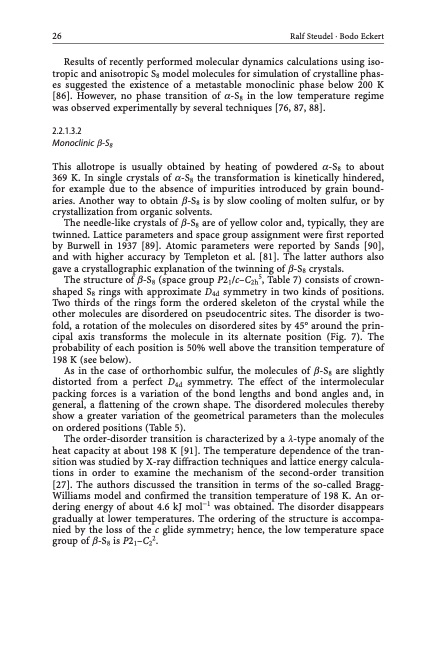
PDF Publication Title:
Text from PDF Page: 036
26 Ralf Steudel · Bodo Eckert Results of recently performed molecular dynamics calculations using iso- tropic and anisotropic S8 model molecules for simulation of crystalline phas- es suggested the existence of a metastable monoclinic phase below 200 K [86]. However, no phase transition of a-S8 in the low temperature regime was observed experimentally by several techniques [76, 87, 88]. 2.2.1.3.2 Monoclinic b-S8 This allotrope is usually obtained by heating of powdered a-S8 to about 369 K. In single crystals of a-S8 the transformation is kinetically hindered, for example due to the absence of impurities introduced by grain bound- aries. Another way to obtain b-S8 is by slow cooling of molten sulfur, or by crystallization from organic solvents. The needle-like crystals of b-S8 are of yellow color and, typically, they are twinned. Lattice parameters and space group assignment were first reported by Burwell in 1937 [89]. Atomic parameters were reported by Sands [90], and with higher accuracy by Templeton et al. [81]. The latter authors also gave a crystallographic explanation of the twinning of b-S8 crystals. The structure of b-S8 (space group P21/c–C2h5, Table 7) consists of crown- shaped S8 rings with approximate D4d symmetry in two kinds of positions. Two thirds of the rings form the ordered skeleton of the crystal while the other molecules are disordered on pseudocentric sites. The disorder is two- fold, a rotation of the molecules on disordered sites by 45 around the prin- cipal axis transforms the molecule in its alternate position (Fig. 7). The probability of each position is 50% well above the transition temperature of 198 K (see below). As in the case of orthorhombic sulfur, the molecules of b-S8 are slightly distorted from a perfect D4d symmetry. The effect of the intermolecular packing forces is a variation of the bond lengths and bond angles and, in general, a flattening of the crown shape. The disordered molecules thereby show a greater variation of the geometrical parameters than the molecules on ordered positions (Table 5). The order-disorder transition is characterized by a l-type anomaly of the heat capacity at about 198 K [91]. The temperature dependence of the tran- sition was studied by X-ray diffraction techniques and lattice energy calcula- tions in order to examine the mechanism of the second-order transition [27]. The authors discussed the transition in terms of the so-called Bragg- Williams model and confirmed the transition temperature of 198 K. An or- dering energy of about 4.6 kJ mol1 was obtained. The disorder disappears gradually at lower temperatures. The ordering of the structure is accompa- nied by the loss of the c glide symmetry; hence, the low temperature space group of b-S8 is P21–C22.PDF Image | Topics in Current Chemistry

PDF Search Title:
Topics in Current ChemistryOriginal File Name Searched:
Elemental-Sulfur-und-Sulfur-Rich-Compounds-I.pdfDIY PDF Search: Google It | Yahoo | Bing
Sulfur Deposition on Carbon Nanofibers using Supercritical CO2 Sulfur Deposition on Carbon Nanofibers using Supercritical CO2. Gamma sulfur also known as mother of pearl sulfur and nacreous sulfur... More Info
CO2 Organic Rankine Cycle Experimenter Platform The supercritical CO2 phase change system is both a heat pump and organic rankine cycle which can be used for those purposes and as a supercritical extractor for advanced subcritical and supercritical extraction technology. Uses include producing nanoparticles, precious metal CO2 extraction, lithium battery recycling, and other applications... More Info
| CONTACT TEL: 608-238-6001 Email: greg@infinityturbine.com | RSS | AMP |